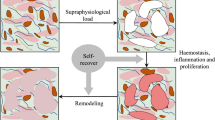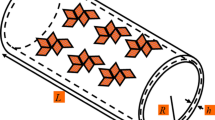Abstract
A curved gradient deficient shell element for the Absolute Nodal Coordinate Formulation (ANCF) is proposed for modeling initially thin curved structures. Unlike the fully parameterized elements of ANCF, a full mapping of the gradient vectors between different configurations is not available for gradient deficient elements, therefore it is cumbersome to work in a rectangular coordinate system for an initially curved element. In this study, a curvilinear coordinate system is adopted as the undeformed Lagrangian coordinates, and the Green–Lagrange strain tensor with respect to the curvilinear frame is utilized to characterize the deformation energy of the shell element. As a result, the strain due to the initially curved element shape is eliminated naturally, and the element formulation is obtained in a concise mathematical form with a clear physical interpretation. For thin structures, the simplified formulations for the evaluation of elastic forces are also given. Moreover, an approach to deal with the on-surface slope discontinuity is also proposed for modeling general curved shell structures. Finally, the developed element of ANCF is validated by several numerical examples.



















Similar content being viewed by others
References
Shabana, A.A.: An absolute nodal coordinate formulation for the large rotation and deformation analysis of flexible bodies. Technical report #MBS96-1-UIC, University of Illinois at Chicago (1996)
Schiehlen, W.: Computational dynamics: theory and applications of multibody systems. Eur. J. Mech. A, Solids 25, 566–594 (2006)
Schiehlen, W.: Research trends in multibody system dynamics. Multibody Syst. Dyn. 18, 3–13 (2007)
Sugiyama, H., Shabana, A.A.: Application of plasticity theory and absolute nodal coordinate formulation to flexible multibody system dynamics. J. Mech. Des. 126, 478–487 (2004)
Sugiyama, H., Shabana, A.A.: On the use of implicit integration methods and the absolute nodal coordinate formulation in the analysis of elasto-plastic deformation problems. Nonlinear Dyn. 37, 245–270 (2004)
Omar, M.A., Shabana, A.A.: A two-dimensional shear deformable beam for large rotation and deformation problems. J. Sound Vib. 243, 565–576 (2001)
Shabana, A.A., Yakoub, R.Y.: Three dimensional absolute nodal coordinate formulation for beam elements: theory. J. Mech. Des. 123, 606–613 (2001)
Sugiyama, H., Suda, Y.: A curved beam element in the analysis of flexible multi-body systems using the absolute nodal coordinates. Proc. Inst. Mech. Eng., Proc., Part K, J. Multi-Body Dyn. 221, 219–231 (2007)
Mikkola, A.M., Shabana, A.A.: A non-incremental finite element procedure for the analysis of large deformation of plates and shells in mechanical system applications. Multibody Syst. Dyn. 9, 283–309 (2003)
Garcia-Vallejo, D., Mikkola, A.M., Escalona, J.L.: A new locking-free shear deformable finite element based on absolute nodal coordinates. Nonlinear Dyn. 50, 249–264 (2007)
Berzeri, M., Shabana, A.A.: Development of simple models for the elastic forces in the absolute nodal co-ordinate formulation. J. Sound Vib. 235, 539–565 (2000)
Gerstmayr, J., Irschik, H.: On the correct representation of bending and axial deformation in the absolute nodal coordinate formulation with an elastic line approach. J. Sound Vib. 318, 461–487 (2008)
Gerstmayr, J., Shabana, A.A.: Analysis of thin beams and cables using the absolute nodal co-ordinate formulation. Nonlinear Dyn. 45, 109–130 (2006)
Dmitrochenko, O.N., Pogorelov, D.YU.: Generalization of plate finite elements for absolute nodal coordinate formulation. Multibody Syst. Dyn. 10, 17–43 (2003)
Dufva, K., Shabana, A.A.: Analysis of thin plate structures using the absolute nodal coordinate formulation. Proc. Inst. Mech. Eng., Proc., Part K, J. Multi-Body Dyn. 219, 345–355 (2005)
Sugiyama, H., Koyama, H., Yamashita, H.: Gradient deficient curved beam element using the absolute nodal coordinate formulation. J. Comput. Nonlinear Dyn. 5, 021001 (2010)
Liu, C., Tian, Q., Hu, H.Y.: New spatial gradient deficient curved thin beam and plate elements of the absolute nodal coordinate formulation. Nonlinear Dyn. 70, 1903–1918 (2012)
Shabana, A.A., Mikkola, A.M.: Use of the finite element absolute nodal coordinate formulation in modeling slope discontinuity. J. Mech. Des. 125, 342–350 (2003)
Shabana, A.A., Maqueda, L.G.: Slope discontinuities in the finite element absolute nodal coordinate formulation: gradient deficient elements. Multibody Syst. Dyn. 20, 239–249 (2008)
Shabana, A.A.: General method for modeling slope discontinuities and T-sections using ANCF gradient deficient finite elements. J. Comput. Nonlinear Dyn. 6, 024502 (2011)
Huang, K.Z.: Nonlinear Continuum Mechanics. Tsinghua University Press, Beijing (1989) (in Chinese)
Kulikov, G.M., Plotnikova, S.V.: Non-linear exact geometry 12-node solid-shell element with three translational degrees of freedom per node. Int. J. Numer. Methods Eng. 88, 1363–1389 (2011)
Arciniega, R.A., Reddy, J.N.: Tensor-based finite element formulation for geometrically nonlinear analysis of shell structures. Comput. Methods Appl. Mech. Eng. 196, 1048–1073 (2007)
Schwarze, M., Reese, S.: A reduced integration solid-shell finite element based on the EAS and the ANS concept-geometrically linear problems. Int. J. Numer. Methods Eng. 80, 1322–1355 (2009)
Sanborn, G.G., Choi, J., Choi, J.H.: Curve-induced distortion of polynomial space curves, flat-mapped extension modeling, and their impact on ANCF thin plate finite elements. Multibody Syst. Dyn. 26, 191–211 (2011)
Borisenko, A.I., Tarapov, I.E.: Vector and Tensor Analysis with Applications. Dover Publications, New York (1979)
Acknowledgements
This work was supported in part by National Natural Science Foundation of China under Grant Nos. 10972036, 10832002, 11221202, 11202025 and 11290151.
Author information
Authors and Affiliations
Corresponding author
Rights and permissions
About this article
Cite this article
Yan, D., Liu, C., Tian, Q. et al. A new curved gradient deficient shell element of absolute nodal coordinate formulation for modeling thin shell structures. Nonlinear Dyn 74, 153–164 (2013). https://doi.org/10.1007/s11071-013-0955-z
Received:
Accepted:
Published:
Issue Date:
DOI: https://doi.org/10.1007/s11071-013-0955-z




